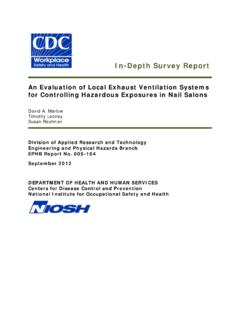Transcription of Configuration Management
1 UNESCO EOLSSSAMPLE CHAPTERSSYSTEMS ENGINEERING AND Management FOR SUSTAINABLE DEVELOPMENT - Vol. I - Configuration Management - Brouse, Peggy S. Encyclopedia of Life Support Systems (EOLSS) Configuration Management Brouse, Peggy S. Systems Engineering and Operations Research Department, George Mason University, USA Keywords: Audits, baseline, change control board, Configuration items, Configuration control, functional Configuration audit, design reviews, hardware control, physical Configuration audit, software control Contents 1. Introduction Definition of Configuration Management History of Configuration Management Application of Configuration Management 2.
2 Configuration Management within the System Lifecycle Project Initiation Phase Inputs to the Project Initiation Phase Project Configuration Management Plan Outputs from the Project Initiation Phase Measurements Project Initiation Phase Baseline Requirements Definition Phase The Identification Function The Control Function Requirements Definition Phase Baseline System Design Phase System Design Phase Baseline Development Phase Formal Test Environment Control Development Phase Baseline Integration and Test Phase Integration and Test Phase Baseline Deployment and Maintenance Phase 3. Configuration Status Accounting and Configuration Auditing Configuration Status Accounting Collection, Recording, and Maintenance of Data Status of Proposed Engineering Changes Change Traceability 4.
3 Configuration Management Responsibilities 5. Configuration Management in Process Improvement 6. Configuration Management Tools Glossary Bibliography Biographical Sketch UNESCO EOLSSSAMPLE CHAPTERSSYSTEMS ENGINEERING AND Management FOR SUSTAINABLE DEVELOPMENT - Vol. I - Configuration Management - Brouse, Peggy S. Encyclopedia of Life Support Systems (EOLSS) Summary Configuration Management is an important activity that is essential for the success of system development projects. Without Configuration Management , uncontrolled changes may result in systems that do not meet user needs, need countless changes, and are often not fielded.
4 Configuration Management (CM) is defined in this article as the process established to maintain the integrity of the work products of a program throughout the system life cycle to include all system components. The processes were identified to: identify a baseline for the Configuration of the system at planned points in the system lifecycle, control changes to the baselined Configuration , ensure the traceability of the Configuration , and produce reports that provide status of the changes to the baseline. CM should be applied to all program hardware, software, and documentation, regardless of whether it is developed, purchased commercial off-the-shelf (COTS), or customer-furnished.
5 CM will be ever more important to organizations not only because of the cost incurred in fixes necessitated by the lack of CM but also because of the increasing necessity for formal CM processes to meet current process standards. 1. Introduction It is critical that Systems Engineering professionals understand and are able to practice CM. It is often the case in systems engineering and Management that: 1. CM is relegated to a secondary role and should not be so neglected. 2. Too many professionals do not practice CM in an organized manner or at all. Effective CM is an important factor in successful system development, and maintenance.
6 In this article, CM will be reviewed in detail including definitions, processes, current practices, and tool sets in CM. Definition of Configuration Management Systems engineering is more than the defined life cycle it follows. In addition to a step-wise or cyclical cycle to be followed, there are a number of infrastructure processes that must be considered through the entire life cycle including Risk Management , Quality Assurance and Configuration Management (CM). CM is necessary in the support of systems development. Configuration Management has been defined by a number of different authors, both in commercial firms and non-commercial organizations.
7 Babich's definition is oriented to software systems and encompasses the identification, organization, and control of software modifications in a development effort. "On any team project, a certain degree of confusion is inevitable. The goal is to minimize this confusion so that more work can UNESCO EOLSSSAMPLE CHAPTERSSYSTEMS ENGINEERING AND Management FOR SUSTAINABLE DEVELOPMENT - Vol. I - Configuration Management - Brouse, Peggy S. Encyclopedia of Life Support Systems (EOLSS) get done. The art of coordinating software development to minimize this particular type of confusion is called Configuration Management . Configuration Management is the art of identifying, organizing, and controlling modifications to the software being built by a programming team.
8 The goal is to maximize productivity by minimizing mistakes". Tichy also addresses the Management of software components. He states "Software Configuration Management [SCM] is a discipline whose goal is to control changes to large software system families, through the functions of: component identification, change tracking, version selection and baselining, software manufacture, and managing simultaneous updates (team work)". Yourdon also recognizes the need not only manage software but to expand CM activities to other system components. "CM has long been recognized as a basic principle of good software engineering.
9 But during the past decade, with the gradual increase in analysis/design modeling techniques, and with the advent of code-generators and CASE tools that transform those models directly into executable code, CM has come to be seen as an important issue throughout the entire life cycle of a system - from the first moment of systems analysis until the last maintenance change is made the system is retired". Freeman also expands the definition to include other components. "Clubs such as Kiwanis, organizations such as the Boy Scouts, and companies such as IBM, carefully distinguish between those that belong to them and those that don't.
10 Further, they may have several categories of members, such as new hire, probationary employee, temporary employee, contractor or retiree. Although they may permit visitors (another category), they are careful (for reasons both good and otherwise) to control membership in the organization. Manufacturers of complex engineered products (for example, refineries, computer systems, airplanes, and machine tools), especially when the products are made up of a number of pieces of equipment, or are one (or few) of a kind, have learned that they must carefully control and keep track of elements of the product.

















